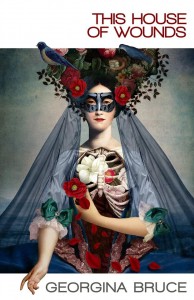
My writing space is an alcove of the dining room using a regular PC, keyboard and screen. It’s not perfect, but when the house is empty or everyone’s asleep it does allow me to create some headspace and it does mean I’m surrounded by books; including the shelves containing everything I’ve been published in (out of shot in the pic). I did have a dedicated office space in the upper part of the house where I wrote for over sixteen years. It was ideal. But when our daughter Cora was born she moved in there so my ‘office’ went downstairs. Seven years later my eldest daughter moved out, Cora moved into her room, and my old office is now my partner’s office. Go figure.
I prefer to write when there’s either no one in the house or everyone is asleep. I’m a bit of a grouch when it comes to being interrupted. If I’m writing short stories then these tend to fall out of me fully formed. I rarely have to edit those other than a few word changes or grammatical edits. I tend to write them in one sitting. Anything longer than four thousand words just depends on the unavailability of everyone else. It can take months to write a novella, snatching a bit of time here and there. So whilst my writing days are few, when I do write it is productive.
Other than listening to music to create a mood (see below), I don’t have any other stimulants. I don’t drink tea or coffee, and very rarely drink alcohol at home. I might just have some ginger beer and some peanuts within reach. Other than that it’s just myself and my imagination.
Because my writing time is rare, anything that can shut out the rest of the world is welcome. Music is perfect for this. I sit down, hit play, and I’m immediately back where I left off in the story. I won’t choose anything too abrasive or lyrically challenging, as this works against the process, but anything subtle can help with ambience. And once I’ve begun writing, the music barely registers, it fades in and out of my consciousness, even when the same song is played over and over (the record for this is “The City Never Sleeps At Night” by Nancy Sinatra which I played seventy times whilst writing a short story called “Blanche” – published in “Something Remains”, Alchemy Press).
Favourites include Bjork, Blonde Redhead, Coeur de Pirate, Nick Cave and the Bad Seeds (but only the album “Push The Sky Away”), late Echobelly, The Flaming Lips. I know some writers prefer soundtracks and although that’s not my thing, for one nature-themed story recently I did write solely to birdsong. A few years ago James Everington asked me a similar question and a link to his blog (with links to the music) is here.
Distractions: the 9-5 day job, the Sunday job, the freelance proofreading I do most evenings… although the biggest distraction is a seven year old who has taken to staying awake til 10pm. On the other hand, my mini-collection “The Forest of Dead Children”, is inspired by my reaction to that. So, swings and roundabouts.
I can’t write without solitude. Interruptions border on the violent.
The most enjoyable part of writing is actually doing it. For me, writing is so much a part of how I identify that having the space and freedom to get on with it allows me to be myself. I don’t find anything about it that isn’t enjoyable. I know a lot of writers aren’t keen on editing, but I don’t tend to do much of that and don’t find it much of an issue. Being immersed in creativity is a real high.
I think my best writing in this space has been what I’ve come to call my ‘celebrity death’ stories. For those reading this who I haven’t already bored to death with this theme, I’ve written twelve stories based on the lives of Golden Era Hollywood celebrities who died young. I really felt I was channeling something important writing these pieces – and occasionally goosebumped myself in the process. They’re intricate, multi-layered, respectful and affectionate. It’s just a shame that I can’t seem to sell them for toffee.
For the first time in about ten years I’ve lost impetus with short stories. The market seems to have shifted and (from my point of view) it appears genre boundaries have returned to parameters which are more clearly defined and my work doesn’t easily sit within that. Last year I began a novel without any idea where it might go and as it turned out it didn’t go more than 7000 words. So I’m in a rare period where I feel disheartened. As an alternative, I’m trying my hand at non-fiction, working on a book about a film. I can’t say much more than that at the moment, but this will be my work for 2020. Of course, writing non-fiction is a hundred ways different to writing fiction: I can’t write with music, I tend to eat constantly, and I actually have to remember stuff and do research. Hopefully it won’t be too long before I’m writing fiction again, but I am enjoying it.
Andrew Hook is an unstable entity whose material form suffers from interdimensional glitching. His fictional output in our dimension has been prolific, with over 150 stories published, as well as several collections, novels and novellas. Find out more here or just go straight to EvilCorp and buy his books.







